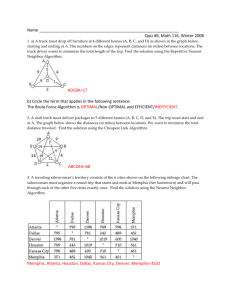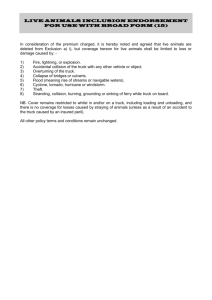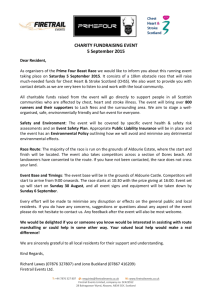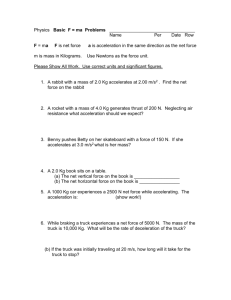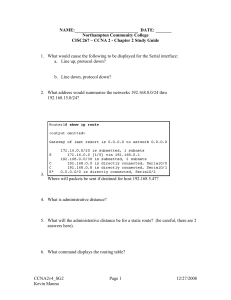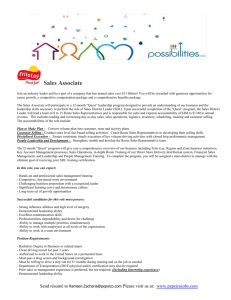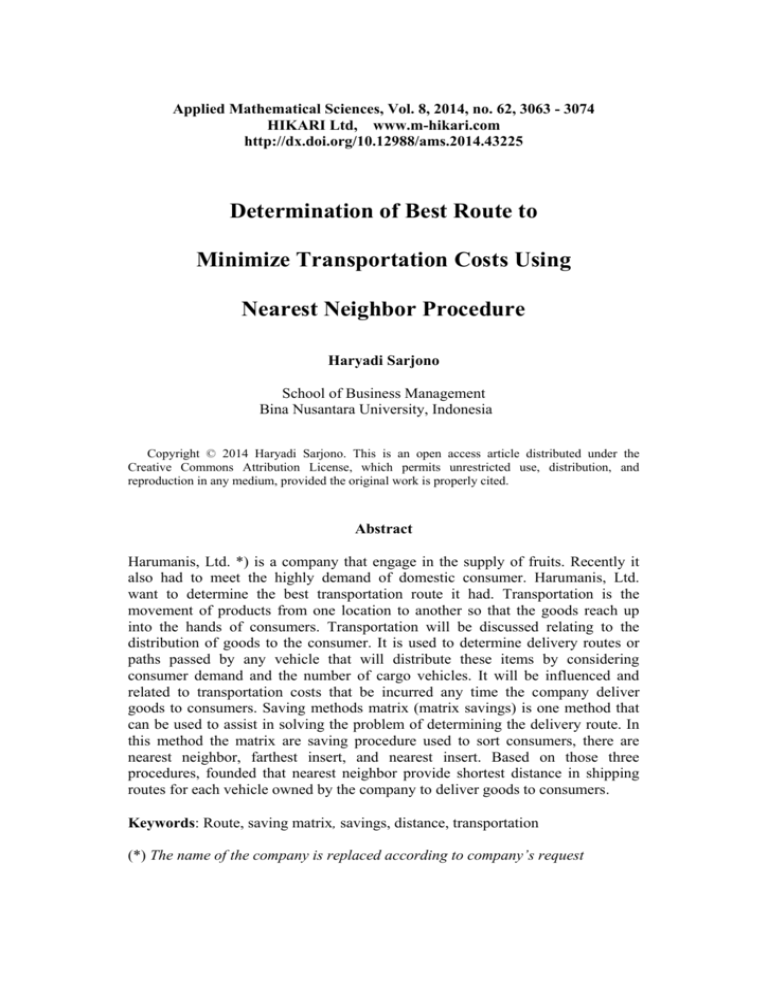
Applied Mathematical Sciences, Vol. 8, 2014, no. 62, 3063 - 3074
HIKARI Ltd, www.m-hikari.com
http://dx.doi.org/10.12988/ams.2014.43225
Determination of Best Route to
Minimize Transportation Costs Using
Nearest Neighbor Procedure
Haryadi Sarjono
School of Business Management
Bina Nusantara University, Indonesia
Copyright © 2014 Haryadi Sarjono. This is an open access article distributed under the
Creative Commons Attribution License, which permits unrestricted use, distribution, and
reproduction in any medium, provided the original work is properly cited.
Abstract
Harumanis, Ltd. *) is a company that engage in the supply of fruits. Recently it
also had to meet the highly demand of domestic consumer. Harumanis, Ltd.
want to determine the best transportation route it had. Transportation is the
movement of products from one location to another so that the goods reach up
into the hands of consumers. Transportation will be discussed relating to the
distribution of goods to the consumer. It is used to determine delivery routes or
paths passed by any vehicle that will distribute these items by considering
consumer demand and the number of cargo vehicles. It will be influenced and
related to transportation costs that be incurred any time the company deliver
goods to consumers. Saving methods matrix (matrix savings) is one method that
can be used to assist in solving the problem of determining the delivery route. In
this method the matrix are saving procedure used to sort consumers, there are
nearest neighbor, farthest insert, and nearest insert. Based on those three
procedures, founded that nearest neighbor provide shortest distance in shipping
routes for each vehicle owned by the company to deliver goods to consumers.
Keywords: Route, saving matrix, savings, distance, transportation
(*) The name of the company is replaced according to company’s request
3064
Haryadi Sarjono
Introduction
Harumanis Ltd.*) is a company engaged in the supply of fruit that located in
South Jakarta. The company sells a wide range of fruits with diverse types; it also
has supplied most of the areas in West Java. The company still experience
problems. It is delaying in shipping goods to consumers, which can affect the
customer satisfaction with the company. As a company engaged in the distribution,
they will aware that the determination of the delivery route used by their vehicle
in shipping activities are very important for the company. Taking into account the
various alternative routes that can be passed by the vehicle at the time of shipping,
the company can obtain the best route may be used. The best route is the route
with the shortest distance, which it certainly will affect the incurred transportation
costs. The shorter the mileage of the vehicle means lower transportation cost.
Distribution is activity that done to move product from supplier to consumer
in a supply chain. Distribution is a key that can provide benefits for the company,
because it can directly impact the cost of the supply chain and consumer needs.
The important thing and must be considered in determining on distribution
management is determining delivery’s schedule and route from one location to
some other locations that become destination. The company is still has limitations
in providing solutions to the problem of distribution of goods, especially in the
selection of shipping routes. It is longer distance required by the vehicle in
shipping goods to consumers and higher cost of transportation.
The problem identification. Is how to determine the best route to minimize
transportation costs by processing the available data using matrix saving methods
and to determine which is the best procedure between the nearest neighbor,
farthest insert and insert nearest. And the research objective of this study. Is to
obtain the best distribution route to minimize transportation costs by using matrix
saving.
Literature Review
Activities of Transportation can be considered as a trip of product to get to
the consumer, from one location to another. It’s because the products
manufactured are consumed directly in the same place [5]. Transport is a repeated
procedure with objective to minimize the costs of a company [4]. According to
Pujawan [3], one of the most important decisions in the distribution of product is
to determine the schedule and shipping route from one location to another. After
the delivery location is known, then the allocation of trucks will be very
meaningful, which truck will be going to which location / store, then calculation
of saving will be started, this method is known as saving matrix [3].
According to El Fahmi [2] saving matrix method is a matrix that contains the
lists of savings gained in combining two agents in one vehicle, in this study is a
truck. Savings matrix method is a method used to minimize time, costs or distance
by considering the existing constraints [3]. The purpose of this method is to
choose assignment of a vehicle and the best routing [1].
Determination of best route
3065
Material and Methods
Research design
This type of research are descriptive and quantitative, where the method of
analysis used in this study is to survey, to observe, and to collect data that
performed in one time (see Table 1).
Table 1. Research design
Research
objectives
Research type
Methods
T-1
descriptive
survey
Analysis units
Shipping section
Time horizon
Cross-sectional
Table 2. Operational Variables
Variables
Sub variables
Determination of
shipping routes
(T-1)
Concept
Delivery route to be passed
by during every activity
done shipping goods to
consumers.
-
Indicator
Saving matrix using
procedures (nearest
neighbor, farthest insert,
and the nearest insert)
Data type and source
Data is relevant, accurate, and according to the needed requirements in research.
The analysis will be conducted to discuss the problem. The data used must be
sourced from the person concerned and also trustworthy (see Table 3).
Table 3. Types and sources of data research
Research objectives
Type of data
Data source
T-1
Quantitative data
Primary data
Table 4. Data collection technique
Research objectives
T-1
Data collection
Interview
Analysis method
Analysis method used by the researcher is saving matrix method with nearest
neighbor, farthest insert, and nearest insert procedures.
Table 5. Analysis method
Research objectives
Analysis technique
T-1
Saving matrix
3066
Haryadi Sarjono
Results and Discussion
Determination of delivering route
Saving matrix method will used in the calculation to get good’s delivery
route on good’s distribution activity to consumer. In saving matrix method, there
are several steps that must be done first to get the best route. These several phases
are:
(1) Creating the distance matrix
The first stage should be done in determine the best delivery route is to get the
position and location of the company's warehouse throughout the consumers’
companies. The company is not used separate warehouse, so the location of
company's warehouse is the location of company itself. Consumers are used in
this study amounted to 15 consumers, as a sample. To facilitate in determining of
shipping routes, the position of each location are obtained by using the map. In
this study used Google Earth application as a map. From existing maps, it can be
obtained the position of each location that are presented in the scale of the X and
Y axes, with center coordinates (0.0) which is the location of the company (K0).
Table 6. Consumer location
Code
Consumer
K1
K2
K3
K4
K5
K6
K7
K8
K9
K10
K11
K12
K13
K14
K15
Muara Bakti
Bekasi
Rajeg
Cileungsi
Tangerang
Citereup
Cisoka
Rumpin
Legok
Jonggol
Balaraja
Cigudeg
Curug
Pamulang
Depok
Coordinates
X
Y
15.8
9
-19.1
6.6
-12.2
2.7
-23
-11.2
-14
11.9
-21.5
16.9
-14
-4.8
-2.1
5.2
-2.1
5.9
11
2.7
-15.8
-2.5
-12.8
-5.2
14.4
1.9
-18.2
-2.3
-6.8
-11.6
The distances between locations, such as the location of A (
to be searched by using the formula (f1):
(
)
√(
)
(
)
) and B (
(f1)
),
Determination of best route
3067
Distance of K1 and K2 (J (1, 2)):
( )
( )
( )
( )
√(
√(
√
)
(
)
)
(
(
))
Distance of K3 and K6 (J(3, 6)):
(
(
(
(
)
)
)
)
√(
√((
√
)
)
(
)
)
(
(
))
Distance of K5 and K10 (J(5, 10)):
(
(
(
(
)
)
)
)
√(
√((
√
)
(
)
)
)
(
)
Here are some of the results of distance calculations (K0 to K10) were obtained
by using the f1 formula above:
Table 7. Distance matrix (K0-K10)
K0
K1
K2
0
K0
16.63
0
K1
9.24
9.98
0
K2
19.99
34.91
29.22
K3
12.83
10.88
13.32
K4
12.50
28.11
21.74
K5
16.03
24.75
15.08
K6
23.14
39.56
32.00
K7
17.01
32.45
22.86
K8
14.93
31.56
23.21
K9
9.99
16.75
K10 18.68
K3
K4
K5
K6
K7
K8
K9
K10
0
26.20
7.61
30.76
9.26
20.30
12.22
32.14
0
20.55
27.08
32.53
29.72
26.21
6.30
0
23.75
11.99
15.53
8.10
26.79
0
28.94
14.22
19.78
31.57
0
15.66
9.40
38.78
0
8.10
35.69
0
32.48
0
(2) Saving matrix determination
From the distance matrix calculation that has been done before, we will calculate
the value of saving matrix. If visiting some consumers every single delivery of
goods. Value of the savings obtained by using the formula:
S(x, y) = J(0, x) + J(0, y) – J(x, y)
(f5)
3068
Haryadi Sarjono
Here are some of calculating savings:
Saving matriks S(1,2):
S(1, 2) = J(0, 1) + J(0, 2) – J(1, 2)
= 16.63+ 9.24 – 9.98
= 15.89 km
Saving matriks S(3,6):
S(3, 6) = J(0, 3) + J(0, 6) – J(3, 6)
= 19.99 + 16.03 – 30.76
= 5.26 km
Saving matriks S(7,9):
S(7, 9) = J(0, 7) + J(0, 9) – J(7, 9)
= 23.14+ 14.93 – 9.40
= 28.67 km
Here are some of the results of the calculation of the value of savings (K1 to K10)
were obtained by using the f5 formula:
Table 8. Saving matriks (K0-K10)
K1
K2
K3
K4
K5
K6
K7
K8
K9
K10
K1
K2
K3
K4
K5
K6
K7
K8
K9
K10
0
15.89
1.71
18.58
1.02
7.91
0.21
1.19
0.00
25.32
0
0.01
8.75
0.00
10.19
0.38
3.39
0.96
11.17
0
6.62
24.88
5.26
33.87
16.70
22.70
6.53
0
4.78
1.78
3.44
0.12
1.55
25.21
0
4.78
23.65
13.98
19.33
4.39
0
10.23
18.82
11.18
3.14
0
24.49
28.67
3.04
0
23.84
0.00
0
1.13
0
(3) Entering into route consumers
The next stage after getting the value of saving (saving the matrix) is entering the
available consumers into the delivery route. At the time of the consumer entering
into a route, it should be noted is that consumer demand for vehicles and cargo
which available. Company own 4 vehicles with each vehicle has a charge of 360
wooden boxes and each box has a weight of 20 kg. The following data which on
consumer demand (see Table 9):
Determination of best route
3069
Table 9. Consumer demand
Code
Consumer
Total demand
K1
K2
K3
K4
K5
K6
K7
K8
K9
K10
K11
K12
K13
K14
K15
Muara Bakti
Bekasi
Rajeg
Cileungsi
Tangerang
Citereup
Cisoka
Rumpin
Legok
Jonggol
Balaraja
Cigudeg
Curug
Pamulang
Depok
85
95
100
120
75
95
95
70
85
80
75
100
70
135
110
Before entering the consumer into the delivery route, the first thing to do is sort
the value of the savings that have been obtained starting from the largest to the
lowest. Here is the 10 largest savings value of the sorting (see Table 10).
Table 10. Ordering results of savings value
No.
1
2
3
4
5
6
7
8
9
10
Consumers pair
K7 and K11
K3 and K11
K3 and K7
K7 and K9
K7 and K13
K11 and K13
K6 and K12
K9 and K13
K9 and K11
K1 and K10
Saving
40.07
36.91
33.87
28.67
28.33
27.17
26.47
26.22
26.18
25.32
Pairs of consumers who have the greatest savings will be placed on the first of the
route of delivery, followed by the pairs of consumers with the second largest
savings, and so on. This process is done until all the consumers get into the
delivery route, and the number of consumer demand can not be longer than cargo
vehicles used to carry freight. Here are the results of consumer entry into a route
that can be seen in the Table 11:
3070
Haryadi Sarjono
Table 11. Grouping consumers into the route
Route
1
2
3
4
Vehicle
Truck 1
Truck 2
Truck 3
Truck 4
Consumers
K7 - K11 - K3 - K9
K13 - K6 - K12 - K1
K10 - K4 - K5 - K8
K15 - K14 - K2
Amount of delivery (galon)
355
350
345
340
(4) Sorting the consumer on the delivery route
At this stage the consumer who has been in every delivery route will do the
ordering. Ordering consumers was conducted to determine which customers will
be visited first when delivery is done so that the distance of delivery process is
closer and which will also affect the cost of transportation. Ordering will be done
using the three procedures, which are nearest neighbor, farthest insert, and the
nearest insert. Here is the sort of consumers with nearest neighbor (see Table 12).
(4a) Consumers who visited the first time is the consumer who has the closest
distance company.
Table 12. First step of nearest neighbor procedure
Route
K0 –K7
K0 – K11
K0 – K3
K0 – K9
Distance (km)
23.14
21.58
19.90
14.93
From the Table 12 it can be seen that the consumer who has the shortest distance
to the starting point (the company) is K9.
(4b) Furthermore, to define the second consumer by selecting consumers who
have the closest distance to the first consumer, which is K9, from the remaining
customers.
Table 13. Second step of nearest neighbor procedure
Route
K9 –K7
K9 – K11
K9 – K3
Distance (km)
9.40
10.33
12.22
From the Table 13, it can be seen that the customers who have the closest
distance to K9 as the first consumer is K7.
(4c) Determining a third of consumers who are the closest consumer with K7
from the remaining consumer.
Determination of best route
3071
Tabel 14. Third step of nearest neighbor procedure
Route
K7 – K11
K7 – K3
Distance (km)
4.65
9.26
From the Table 14 it can be decided that a consumer who has the shortest
distance to the K7 is K11.
(4d) After the K11 set to become the third consumer so the remaining one is K3,
and K3 will be the last consumer who will visited by a vehicle at the time of
delivery, then the vehicle will be returned to the company.
Table 15 are the results of sorting consumers which will be visited from any
vehicle using the nearest neighbor procedure.
Table 15. Ordering the consumer with nearest neighbor
Route
Vehicle
Consumer
1
Truck 1
K0 - K9 - K7 - K11 - K3 - K0
2
Truck 2
K0 - K13 - K6 - K12 - K1 - K0
3
Truck 3
K0 - K5 - K8 - K4 - K10 - K0
4
Truck 4
K0 - K14 - K15 - K2 - K0
Distance (km)
53.63
90.12
76.88
37.68
Cost calculation
In this study costs transportation consist of fuel costs, labor costs, vehicle
maintenance costs, and tax costs. These data can be seen in vehicle operating
costs table below (see Table 16):
Table 16. Vehicle operating costs
Operational cost
Cost
Truck price 1
IDR155,000,000
Truck price 2
IDR160,000,000
Truck price 3
IDR175,000,000
Truck price 4
IDR175,000.000
Fuel costs
IDR6,000 / litre
Wages driver
IDR1,500,000 / month
Wages companion driver
IDR1,300,000 / month
Maintenance costs
IDR1,000,000 / month
Truck tax costs 1
IDR2,050,000 / year
Truck tax costs 2
IDR2,250,000 / year
Truck tax costs 3
IDR2,100,000 / year
Truck tax costs 4
IDR2,225,000 / year
Notes: IDR is the abbreviation name of Indonesian currency
(Indonesian Rupiahs)
Fuel costs (diesels)
Based on the interview to the driver of the company, the ratio of fuel to distance
traveled is 1: 10, which means that 1 litre of fuel used to travel 10 km distance.
3072
Haryadi Sarjono
From there, it can be said sthat the cost of fuel for the first mile traveled is IDR
600. Thus it can be carried out calculations for fuel costs on each route are
available, following the results of the calculations.
Table 17. Fuel cost for each route
No
Vehicle
Procedure
1
Truck 1
Nearest neighbor
2
Truck 2
Nearest neighbor
3
Nearest neighbor
Truck 3
4
Nearest neighbor
Truck 4
Distance (km)
53.63
90.12
76.88
Cost
IDR32,178.00
IDR54,072.00
IDR46,128.00
37.68
IDR22,608.00
Depreciation costs
Depreciation of vehicles are 10% per year and the number of working days used
to make deliveries is 265 days. With these data it can do calculations to determine
the cost per day. The calculations are as follows:
Truck depreciation cost 1
= IDR155,000,000 x 10% : 265
= IDR58,490.57 / day
Truck depreciation cost 2
= IDR160,000,000 x 10% : 265
= IDR60,377.36 / day
Truck depreciation cost 3
= IDR175,000,000 x 10% : 265
= IDR66,037.74 / day
Truck depreciation cost 4
= IDR175,000,000 x 10% : 265
= IDR66,287.88 / day
Labor costs
The company uses two workers each time they make delivery of goods to
consumers, one person as a driver and another person as a co-driver. From the
table it can be seen operating costs of wages and wage driver escort driver. From
the data obtained show that the cost per day for labor senders are IDR112,000 /
day.
The cost of vehicle tax
Costs incurred for vehicle tax, which can be seen in vehicle operating table above,
is the cost per year. Therefore, the cost will be divided by the number of working
days per year to get the cost per day. The calculations are as follows:
Tax cost of truck 1
Tax cost of truck 2
Tax cost of truck 3
Tax cost of truck 4
= IDR2,050,000 / year : 265 = IDR7,735.85 / day
= IDR2,250,000 / year : 265 = IDR8,490.57 / day
= IDR2,100,000 / year : 265 = IDR7,924.53 / day
= IDR2,225,000 / year : 265 = IDR8,396.23 / day
Determination of best route
3073
Maintenance cost
Maintenance costs that must be issued by the company for the entire vehicle on a
monthly basis amounted to IDR1,000,000. Thus the maintenance cost per vehicle
per day is calculated as follows:
Cost of care per day
= (IDR1,000,000 / 4) / 25
= IDR10,000 / day / car
Based on the calculation of the costs associated with shipping goods to consumers,
it can calculate costs the companies spend on each shipping activity performed.
Here are the results of calculation of incurred shipping costs each time a company
performed delivery activities by using a pre-determined route.
Total expense for the first truck with the nearest neighbor procedure
Total cost = IDR32,178.00 + IDR58,490.57 + IDR112,000+ IDR7,735.85 +
IDR10,000 = IDR220,404.42
Total expense for the second truck with the nearest neighbor procedure
Total cost = IDR54,072.00 + IDR60,377.36 + IDR112,000 + IDR8,490.57 +
IDR10,000 = IDR244,939.93
Total expense for the third truck with the nearest neighbor procedure
Total cost = IDR46,128.00 + IDR66,037.74 + IDR112,000 + IDR7,924.53 +
IDR10,000 = IDR242,090.27
Total expense for the fourth truck with the nearest neighbor procedure
Total cost = IDR22,608.00 + IDR66,287.88 + IDR112,000 + IDR8,396.23 +
IDR10,000 = IDR219,292.11
Conclusion
Based on the results of the analysis has been carried out, the conclusion that
the method of saving matrix can assist in cope with the problem of determining
the delivery route so the distance through which the shipment may be closer.
From the three procedures, nearest neighbor procedure is a procedure that
produces consumer ordering the shortest distance for each vehicle used in
shipping goods to corporate customers. Based on research that has been done, the
advice can be given to the company is the company should make the
determination of the distribution route to determine the best path so as to
minimize the shipping costs prior to shipment of goods to consumers do.
3074
Haryadi Sarjono
References
[1] D. J. Bowersox, Manajemen Logistik, Jakarta: Bumi Aksara, 2006.
[2] E. F. F. El Fahmi, "Studi Komparasi Penyelesaian Capacitated Vehicle
Routing Problem (CVRP) dengan Metode Saving Matrix dan Generalized
Assignment," Jurnal Mahasiswa Matematika, vol. 1, no. 4, 2013.
[3] I. N. Pujawan, Supply Chain Management, 2nd ed., Surabaya, Indonesia:
Guna Widya, 2010.
[4] J. Heizer and B. Render, Manajemen Operasi, 7th ed., Jakarta, Indonesia:
Salemba Empat, 2005.
[5] S. Chopra and P. Meindl, Supply Chain Management: Strategy, Planning, and
Operation, New Jersey, USA: Pearson Prentice Hall, 2010.
Received: March 31, 2014

